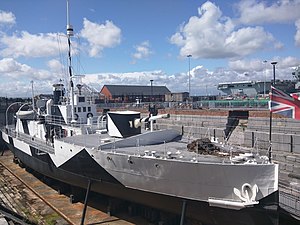
A monitor is a relatively small warship that is neither fast nor strongly armored but carries disproportionately large guns. They were used by some navies from the 1860s, during the First World War and with limited use in the Second World War.

The M29 class comprised five monitors of the Royal Navy, all built and launched during 1915.
Eight vessels of the British Royal Navy have been named HMS Minerva, after the goddess Minerva of Roman mythology.

HMS Caroline is a decommissioned C-class light cruiser of the Royal Navy that saw combat service in the First World War and served as an administrative centre in the Second World War. Caroline was launched and commissioned in 1914. At the time of her decommissioning in 2011 she was the second-oldest ship in Royal Navy service, after HMS Victory. She served as a static headquarters and training ship for the Royal Naval Reserve, based in Alexandra Dock, Belfast, Northern Ireland, for the later stages of her career. She was converted into a museum ship. From October 2016 she underwent inspection and repairs to her hull at Harland and Wolff and opened to the public on 1 July 2017 at Alexandra Dock in the Titanic Quarter in Belfast.
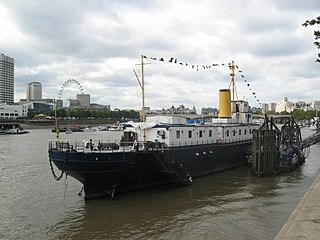
HMS President is a retired Flower-class Q-ship that was launched in 1918. She was renamed HMS President in 1922 and moored permanently on the Thames as a Royal Navy Reserve drill ship. In 1982 she was sold to private owners and, having changed hands twice, served as a venue for conferences and functions as well as the offices for a number of media companies. She has been moved to Chatham on the Medway in Kent since 2016, but is due to return to the capital. She had the suffix "(1918)" added to her name in order to distinguish her from HMS President, the Royal Naval Reserve base in St Katharine Docks. She is one of the last three surviving Royal Navy warships of the First World War. She is also the sole representative of the first type of purpose built anti-submarine vessels, and is the ancestor of World War II convoy escort sloops, which evolved into modern anti-submarine frigates.
The National Museum of the Royal Navy, Portsmouth, formerly known as the Royal Naval Museum, is a museum of the history of the Royal Navy located in the Portsmouth Historic Dockyard section of HMNB Portsmouth, Portsmouth, Hampshire, England. The museum is part of the National Museum of the Royal Navy, a non-departmental public body sponsored by the Ministry of Defence. It received 1,081,909 visitors in 2017.
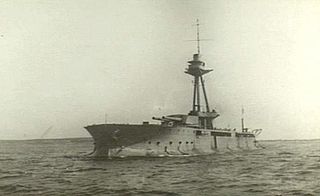
HMS Abercrombie was a First World War Royal Navy Abercrombie-class monitor.

The Flower class comprised five sub-classes of sloops built under the Emergency War Programme for the Royal Navy during World War I, all of which were named after various flowers. They were popularly known as the "herbaceous borders", in humorous reference to a well-known adage about the Royal Navy, as well as to a type of garden arrangement popular in the United Kingdom.

The Aubrietia-class sloops were a class of twelve sloops built under the Emergency War Programme for the Royal Navy in World War I as part of the larger Flower class. They were also referred to as the "cabbage class", or "herbaceous borders". The Flowers were the first ships designed as minesweepers.

HMS Grafton was a first class cruiser of the Edgar class, launched in 1892. She served in colonial service and in the First World War. Grafton survived the war and was broken up in the 1920s.
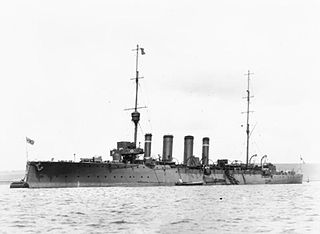
HMS Dartmouth was a Town-class light cruiser built for the Royal Navy in the 1910s. She was one of the Weymouth sub-class of the Town class. The ship survived the First World War and was sold for scrap in 1930.

HMS Severn was a Humber-class monitor of the Royal Navy. Originally built by Vickers for Brazil, she was purchased by the Royal Navy in 1914 on the outbreak of the First World War along with her sister ships Humber and Mersey. She had been christened Solimoes by the Brazilians, but was renamed by the British. The three ships were the first of a new type of specialized shore-bombardment warships. As a result of her shallow draught, she was very un-manoeuvrable and unseaworthy in open waters in anything more than a Force 5 wind.

HMS Humber was a Humber-class monitor of the Royal Navy. Originally built by Vickers for Brazil as Javary, she was purchased by the Royal Navy in 1914 on the outbreak of the First World War along with her sister ships Severn and Mersey.
HMS M32 was an M29-class monitor of the Royal Navy.

The M15 class comprised fourteen monitors of the Royal Navy, all built and launched during 1915.
HMS M28 was a First World War Royal Navy M15-class monitor. She was sunk during the Battle of Imbros in 1918.
HMS M27 was a First World War Royal Navy M15-class monitor. She was also served in the British intervention in Russia in 1919, and was scuttled in the Dvina River on 16 September 1919.
HMS M25 was a First World War Royal Navy M15-class monitor. She was also served in the British intervention in Russia in 1919, and was scuttled in the Dvina River on 16 September 1919.
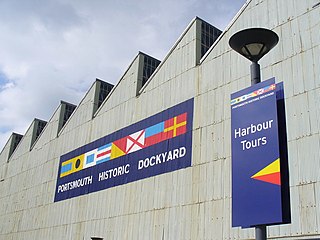
Portsmouth Historic Dockyard is an area of HM Naval Base Portsmouth which is open to the public; it contains several historic buildings and ships. It is managed by the National Museum of the Royal Navy as an umbrella organization representing five charities: the Portsmouth Naval Base Property Trust, the National Museum of the Royal Navy, Portsmouth, the Mary Rose Trust, the Warrior Preservation Trust Ltd and the HMS Victory Preservation Company. Portsmouth Historic Dockyard Ltd was created to promote and manage the tourism element of the Royal Navy Dockyard, with the relevant trusts maintaining and interpreting their own attractions. It also promotes other nearby navy-related tourist attractions.
